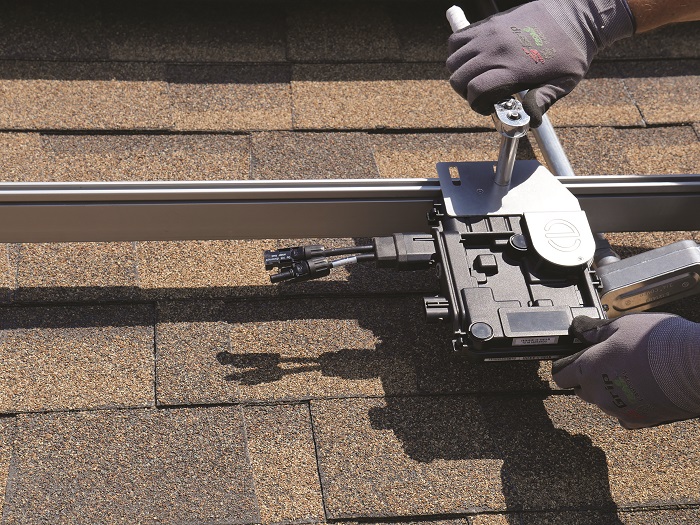California-headquartered microinverter specialist Enphase Energy has today announced the launch of its new IQ microinverter that the company claims can be a game-changer for the residential solar industry.
First unveiled at the Solar Power International exhibition last September, the IQ microinverter improves upon Enphase’s previous iteration – the S-series microinverter – in a handful of ways. Firstly, it is 30% lighter and thus easier to install. This is achieved via the use of a double-insulated non-corroding polymeric enclosure that has enabled Enphase to reduce its size.
Inside the enclosure is a new two-wire Q cable that utilizes 50% less copper, helping to bring down weight and shore-up the IQ’s safety and reliability. As with previous Enphase microinverters, the new IQ is both NEC 2014 and 2017 compliant, meaning that it meets the rapid shutdown requirements of the U.S. National Electrical Code (NEC) as well as individual states’ own demands – including Rule 21 in California and the Hawaiian Electric Company Rule 14H (which stipulates certain standards pertaining to power factor, voltage and frequency regulation).
However, perhaps the most interesting upgrade inherent in the IQ is its integration possibilities. This new Enphase microinverter underpins the firm’s Energized AC Modules, which are smart solar modules shipped with the IQ Microinverter pre-installed. These modules will be available in the U.S. this summer via leading brands, incuding LG, SolarWorld and JinkoSolar.
Demand for AC modules is expected to grow strongly over the next few years because they offer higher power output, simplified installation, lower capital costs and a streamlined supply chain as the MLPE (module-level power electronics) functionality is installed at the production stage.
“Our IQ technology will enable the introduction of Enphase Energized AC Modules, which will be the ultimate game-changer for the residential solar industry,” said Enphase CEO Paul Nahi.
This content is protected by copyright and may not be reused. If you want to cooperate with us and would like to reuse some of our content, please contact: editors@pv-magazine.com.



Are these inverters suitable for Indian Market?
Are these inverters/AC Modules suitable for Indian Market
I have SolarEdge and Enphase products. But starting to think this now *won’t* be the future.
Previously the premise of MLPE is that we can get more out of valuable solar modules (as well as achieving monitoring and remote shutdown) using smart technology. But with global super projects at MW size now being completed at less than 40c/W USD in some markets – is the argument for enhancing yield through tech dead ? If SolarEdge costs 15c/W extra than string, or Enphase, this is a 30% cost uplift, are they going to deliver 30% extra yield over SMA with Optitrack on commercial systems ? Unlikely.
The problem is that the Enphase system doe not allow DC to DC conversion of energy to batteries which means storage is a losing game for Enphase as storage IS the wave of the future for PV systems . Also Enphase clips power at the source meaning it will never deliver as much power as DC Optimizers and after about 10 modules they lose there price advantage against a Company like SolarEdge who has about 10% more direct solar power delivered during the day and have an obvious DC to DC storage solution for large battery systems . Microinverters will never be used in large grid tied systems due to ineffiency and erratic monitoring problems .